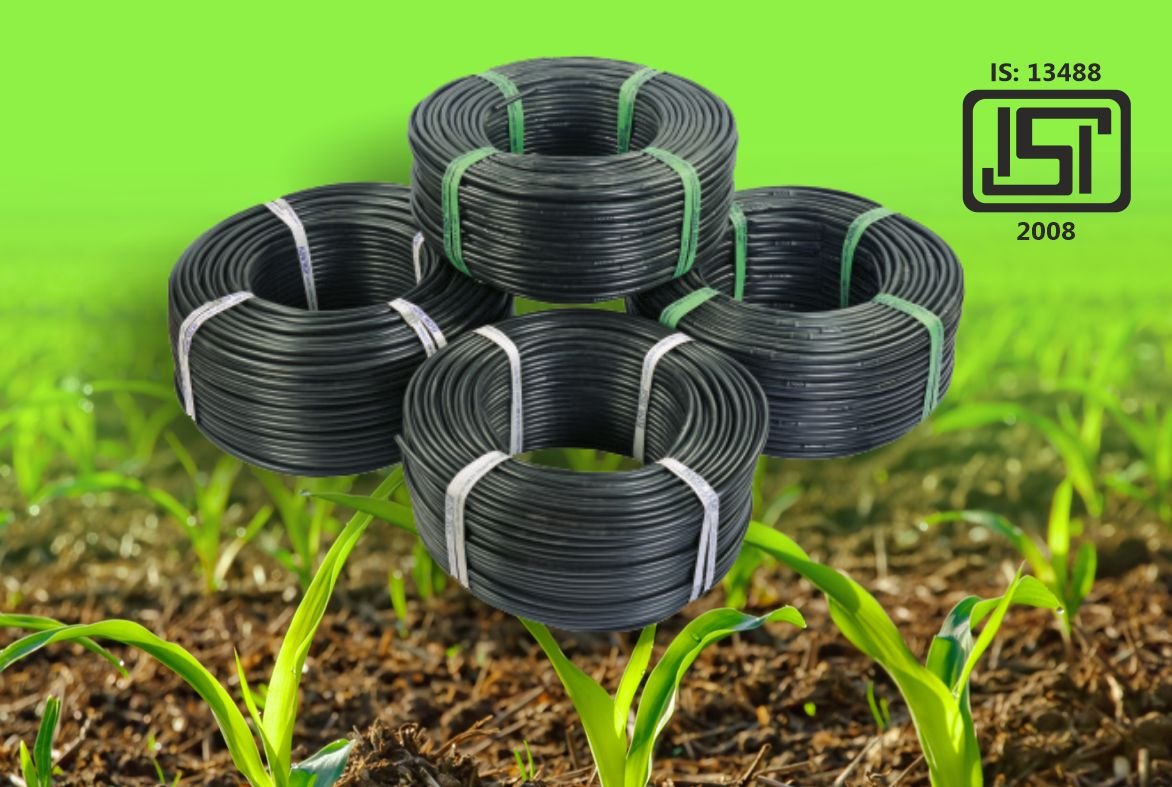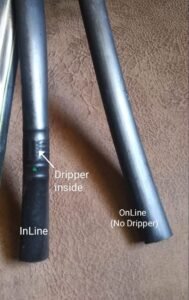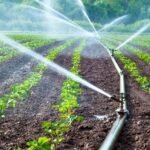
DRIP IRRIGATION PIPES
GRKG Overseas is a company known for manufacturing and supplying various agricultural products, including drip irrigation pipes. Drip irrigation pipes from GRKG Overseas are designed to deliver water efficiently and directly to the roots of plants, promoting optimal growth while conserving water.
Features of GRKG Overseas Drip Irrigation Pipes
- High-Quality Materials:
- Made from durable polyethylene or PVC, which ensures longevity and flexibility.
- Resistant to UV rays, which helps prevent degradation when exposed to sunlight.
- Variety of Emitters:
- Integrated emitters spaced at regular intervals along the pipe.
- Emitters designed to deliver water at different flow rates to suit various plant needs.
- Pressure Regulation:
- Compatible with pressure regulators to maintain consistent water pressure.
- Ensures efficient water distribution and prevents system damage due to high pressure.
- Filtration Systems:
- Equipped with filters to prevent clogging and ensure a clean water supply.
- Maintains the efficiency and longevity of the drip irrigation system.
- Easy Installation and Maintenance:
- Comes with connectors and fittings for easy assembly and customization.
- Low maintenance requirements due to robust design and quality materials.
Benefits of Using GRKG Overseas Drip Irrigation Pipes
- Water Conservation: Delivers water directly to the root zone, minimizing evaporation and runoff.
- Cost Savings: Reduces water bills and labor costs associated with manual watering.
- Enhanced Plant Health: Provides consistent moisture levels, reducing plant stress and promoting healthier growth.
- Weed Reduction: Limits water to specific areas, reducing weed growth in non-target zones.
- Versatility: Suitable for various agricultural applications, including crop fields, orchards, vineyards, and gardens.
Applications
- Agriculture: Ideal for a wide range of crops, including vegetables, fruits, and field crops.
- Horticulture: Used in gardens, greenhouses, and nurseries for efficient watering.
- Landscaping: Suitable for residential and commercial landscapes, lawns, and flowerbeds.
There are various types of irrigation drip pipes designed to meet different agricultural and horticultural needs. Here’s an overview of the main types:
1. Inline Drip Pipe

Version 1.0.0
- Description: Has built-in emitters spaced at regular intervals along the length of the pipe.
- Use: Ideal for row crops, vegetable gardens, and landscaping.
- Advantages: Uniform water distribution, easy installation.
2. Online Drip Pipe
- Description: Uses external emitters that can be attached anywhere along the pipe.
- Use: Suitable for irregular planting patterns, orchards, and vineyards.
- Advantages: Flexible emitter placement, customizable to specific plant needs.
3. Porous Soaker Hose

Version 1.0.0
- Description: Made from recycled rubber or polyethylene, it oozes water along its length.
- Use: Effective for garden beds, borders, and around shrubs.
- Advantages: Even water distribution along the entire hose, easy to install.
4. Subsurface Drip Irrigation (SDI) Pipe
- Description: Buried below the soil surface, delivers water directly to the root zone.
- Use: Ideal for row crops, turf, and areas with high evaporation rates.
- Advantages: Minimizes evaporation, reduces surface runoff, efficient water use.
Choosing the Right Type
When selecting a drip irrigation pipe, consider the following factors:
- Crop Type: Different crops have varying water needs and planting patterns.
- Terrain: Pressure-compensating pipes are better for uneven terrain.
- Water Source: Quality and pressure of the water supply influence the choice of pipe and emitters.
- Budget: Cost considerations can influence the choice between high-end and economical options.
Using the appropriate type of drip irrigation pipe can significantly enhance water efficiency, reduce costs, and promote healthier plant growth.
The quality of drip irrigation pipes is crucial for ensuring the efficiency, durability, and effectiveness of an irrigation system. Here are the key factors that determine the quality of drip irrigation pipes:
1. Material Quality
- Polyethylene (PE): High-quality PE is durable, flexible, and resistant to UV rays and chemicals, making it a preferred choice.
- PVC: While less flexible than PE, high-quality PVC pipes are strong and long-lasting.
- Recycled Materials: Some drip pipes use recycled materials, which can be cost-effective but may vary in durability.
2. UV Resistance
- Importance: UV-resistant materials prevent degradation from sunlight exposure, prolonging the pipe’s lifespan.
- Indicators: Pipes should have UV stabilizers or be labeled as UV-resistant.
3. Durability and Flexibility
- Durability: High-quality pipes resist cracking, splitting, and abrasion.
- Flexibility: Good flexibility allows pipes to be easily laid out around plants and obstacles without kinking.
4. Emitter Quality
- Consistent Flow Rate: High-quality emitters provide a consistent flow rate, ensuring even water distribution.
- Clog Resistance: Emitters should be designed to resist clogging from sediments or impurities in the water.
5. Pressure Rating
- Importance: Pipes should withstand the operating pressure of the irrigation system without bursting or leaking.
- Rating: Check the manufacturer’s pressure rating to ensure compatibility with your system’s pressure.
6. Manufacturing Standards
- ISO Certification: Pipes manufactured according to ISO standards (such as ISO 9261) meet international quality criteria.
- Quality Control: Reputable manufacturers have stringent quality control processes to ensure product consistency.
7. Wall Thickness
- Thicker Walls: Provide better durability and resistance to physical damage.
- Application: Wall thickness may vary based on application (e.g., thicker for subsurface systems, thinner for temporary setups like drip tape).
8. Chemical Resistance
- Importance: Pipes should resist chemicals and fertilizers commonly used in agriculture to prevent degradation.
- Indicators: Look for specifications indicating chemical resistance.
Drip irrigation pipes come in various sizes to suit different applications, water flow requirements, and installation preferences. Here are the common sizes and their typical uses:
1. Mainline Pipes
- Diameter: Typically ranges from 16mm to 32mm (1/2 inch to 1 inch).
- Use: These larger pipes serve as the main water supply lines that distribute water to different sections of the irrigation system.
- Common Sizes:
- 16mm (1/2 inch)
- 20mm (3/4 inch)
- 25mm (1 inch)
- 32mm (1 1/4 inch)
2. Sub-Main Pipes
- Diameter: Usually between 12mm and 20mm.
- Use: Sub-main pipes branch off from the mainline to deliver water closer to the specific planting areas.
- Common Sizes:
- 12mm (3/8 inch)
- 16mm (1/2 inch)
- 20mm (3/4 inch)
3. Lateral Pipes
- Diameter: Typically 12mm to 16mm.
- Use: These pipes run along the rows of plants, delivering water directly to the emitters.
- Common Sizes:
- 12mm (3/8 inch)
- 16mm (1/2 inch)
Summary
Choosing GRKG Overseas drip irrigation pipes ensures you benefit from high-quality, durable materials, efficient water use, innovative designs, and cost-effective solutions. Their versatility, ease of installation, and strong customer support make them a reliable choice for a wide range of agricultural and horticultural applications. By investing in GRKG Overseas products, you can enhance your irrigation efficiency, promote sustainable practices, and achieve better plant health and productivity.


